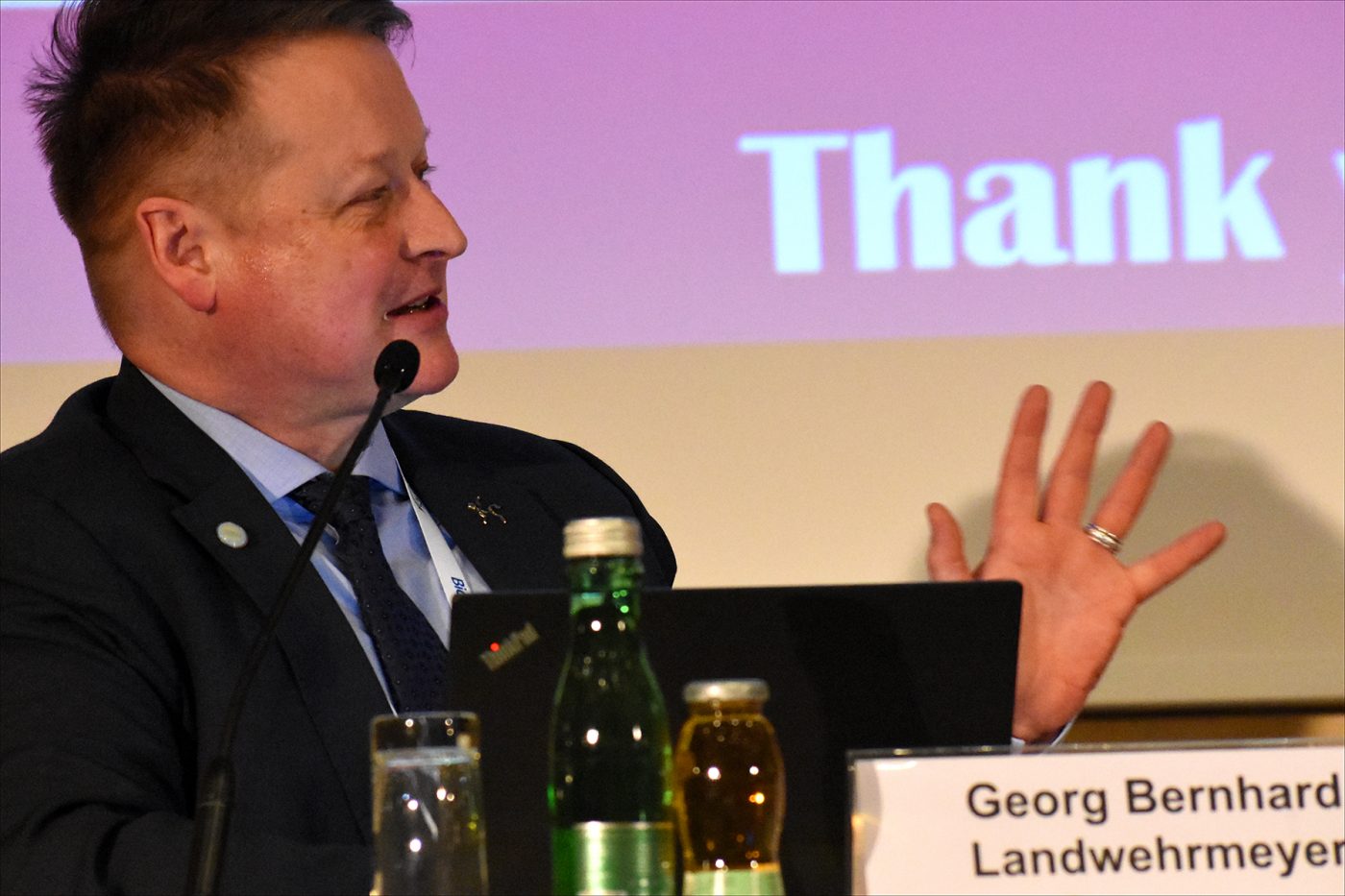Global Enroll-HD Study Aims for Up to 30,000 Patients by 2023
Written by |

George Bernhard Landwehrmeyer, a neurologist, speaks at ECCH2020 in Vienna. (Photo by Larry Luxner)
Enroll-HD, the world’s largest observational study of Huntington’s disease, hopes to add thousands of patients to its registry, reaching a possible total of 30,000 over the next three years.
Georg Bernhard Landwehrmeyer, MD, its principal investigator, spoke about the ambitious project at last month’s European Conference on Controversies in Huntington’s Disease in Vienna.
“It’s our job as clinicians that we have a thorough understanding of the phenotypes we’re going to encounter,” Landwehrmeyer, a neurologist and professor at Germany’s University of Ulm, said at the Feb. 13–14 event.
Enroll-HD builds on two other natural history studies, he said. The larger of the two was the REGISTRY study, conducted in Europe under his leadership with about 15,000 participants. The smaller was COHORT —conducted under the auspices of the Rochester, New York-based Huntington Study Group — with about 3,000 patients.
Since its establishment in 2011, Enroll-HD has signed up 23,278 patients speaking 18 languages in at least 20 countries; more than 85% are still active in the study. It encompasses 185 sites across the United States, Canada, Latin America, Europe, Australia, and New Zealand.
About 60 people are working on Enroll-HD worldwide, he said.
“This study is based on the idea that you need native speakers embedded into the local culture. So in most European countries, we’ll have either a physician or neuropsychologist working for the project,” said Landwehrmeyer, adding that it employs four people just for German-speaking countries, and that in the U.S., it’s being outsourced to a branch of IQVIA, which specializes in data science.
Its end goals: to better understand the disease and its course by monitoring people in “real-world settings” over time, and to better treat patients, in part by building a research platform that enables faster and smarter clinical trial recruitment.
“We believe that one of the advantages of our study is that you can screen for potential participants in clinical trials on the database,” Landwehrmeyer said. “You have to have regularly updated information as to their clinical status. Currently, most of the clinical studies that aim to modify progression of the disease are focused on the early stages of Huntington’s.”
Enroll-HD seeks ‘basic information’
The mean age of participants in Enroll-HD is late 40s, with only about 3,000 people in early stages of the disease.
“More and more frequently, we’re seeing people with late-onset Huntington’s, because people are living longer,” he said. “It takes time for the disease to manifest clinically. In the old days, people didn’t make it to much past 60, so we missed older folks who developed their first clinical symptoms around age 70.”
He added: “Very often it happens that it’s their children who may present earlier, particularly with male transmission.”
Landwehrmeyer, past chairman of the executive committee of the European Huntington’s Disease Network, said Enroll-HD aims to build one global study with identical assessments, and independent of a patient’s region.
“The idea of Enroll-HD is to get basic information once a year, and to link that basic information to additional studies or platforms in order to phenotype people with Huntington’s more deeply. We also want to acquire, in a targeted fashion, biomaterials like blood, serum, sperm, cerebrospinal fluid and muscle biopsy — whatever is appropriate to address the scientific question at hand.”
All these data are being analyzed at a central laboratory in Milan, Italy. The effort is funded entirely by the nonprofit CHDI Foundation, which spends between $80 million and $120 million a year on Huntington’s research.
Landwehrmeyer pointed out that Huntington’s is more than just a movement disorder.
“It’s also a neuropsychiatric disorder with personality changes and cognitive deficits,” he said. “We think of the disease science emerging as a reflection of a change in the function of neurons. People don’t realize that something is wrong. You know too well what the implications are. I think the vast majority of patients also know perfectly well, but they find it very difficult to admit consciously to themselves and to others what they notice.”
Research for the future
The best estimate of Huntington’s prevalence in the West is 10 to 15 per 100,000 inhabitants, Landwehrmeyer said.
Huntington’s is caused by excessive repeats of a portion of DNA called CAG trinucleotide repeats within the huntingtin (HTT) gene. Healthy people usually have up to 36 CAG repeats; those with more than 36 develop the disease. Research shows that the length of inherited CAG repeats in that gene determines the age at which motor symptoms appear, with longer repeat expansions leading to earlier onset.
“Huntington’s is a monogenetic disorder, so you’d expect a more uniform phenotype, but that is not what we actually see,” Landwehrmeyer said. “Due to the fact there is variation in the nature of the mutation, there is also variation in clinical presentation. And that depends on the size of the CAG expansion mutation. With longer CAG repeat expansions, parkinsonism and dystonia dominate the clinical presentation.”
But the reality is that new mutations of Huntington’s will always appear because of the relatively high number of people who have a CAG repeat size between 27 and 35, he said.
“Up to 20% of the patient population harbors an expandable range,” Landwehrmeyer said. “This indicates that even if all folks who are known to have Huntington’s in the family decide not to propagate, the problem wouldn’t go away because there will always be new people moving from the expandable range into the pathological range.”
For now, available treatments ease the signs and symptoms of Huntington’s, but nothing can stop or slow the disease’s downhill course
Still, he said, it’s not difficult to enlist Huntington’s participants in studies when compared to other neurodegenerative diseases like amyotrophic lateral sclerosis (ALS). This is partly because Huntington’s is purely genetic, so patients know if it runs in their families.
And it’s because average survival after a Huntington’s diagnosis is 21 years, compared to three years for ALS.
“Patients are interested in making life better for the following generation, so it’s very easy to recruit,” Landwehrmeyer said. “They all have a vested interest in doing something about it.”







